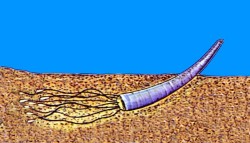(sca-phoda:
from the Latin scaphe=boat , and pous=foot: boat - foot!)
 |
All scaphoda species,
a mere 200 or so, are marine inhabitants that live partially buried in
sand or gravel all their lives. The tusk or tooth shells, as they
are more commonly known, have the simplest shell structure and anatomy
of all the molluscs. They show very little variation in structure except
that the members of the Dentalium resemble elephant tusks, while those
of the Cadulus class look like swollen cucumbers open at each end.
|
The
number and shape of the longitudinal ribs along with the coloration and curious
slots appearing along the edge of the smaller posterior end of their shell all
help to distinguish the various species of tusk shells.
They
are relatively inactive creatures with a low metabolic rate and a very simple
anatomy. Scaphopods generally burrow in the sand at depths ranging from 18(6
meters) to 600 feet (200 meters), however, a few do inhabit shallower waters
and some have even been found in the oceans' deepest trenches.
|
|
- Order Dentaliida
Boss, in Parker,1982
- Order [Dentalioida]
- SF:Order Dentaliida
T=Middle Ordovician to Present
- Order Gadilida
Boss, in Parker,1982
- Order [Siphonodentalioida]
- SO:Order Gadilida
1987; T=Permian to Present
|
|
|
The western tribes of North American Indians once used tusk shells
extensively, first as necklaces and later as money belts (Wampum) to be traded
with other tribes, and the white man. (See a Hoopa
dentalium purse)
Anatomy
Diagram
The shells of most species average between one
to two inches (2.5 cams. ­ 5 cms.) in length; ranging from 4 mm (Cadulus
mayori) to a maximum of about 150mm (6") (Dentalium vernedei Sowerby,
1860). The name "tusk shell" is derived from the fact that it
resembles the shape of an elephant's tusk. The shell is usually an elongated,
cylindrical tube, open at both ends, and slightly curved. However, some of the
scaphoda shells are shaped more like a swollen cucumber. The shell is
usually heavily ribbed and has small slits at the narrowest end. Colours range
from white & off-white, cream, brown to an attractive variety of greens.
The foot extends from the larger end of the shell and is spade or cone
shaped. It is projected downwards, so the animal can burrow with it.
It also serves as a means of an anchor for the animal. Finally, by the
contracting and expanding motions, the foot also keeps water passing in and
out of the posterior half of the mantle cavity which in turn causes blood circulation.
| Water Circulation
& Respiration: |
The mantle cavity is
large and extends the entire length of the ventral surface of the scaphopod.
Water slowly enters this cavity as a result of ciliate action (many small cilia
all beating in the same direction). The cilia are concentrated on the
vertical ridges of the mantle wall, approximately midway on the animal.
The remaining mantle wall is only weakly ciliated. There are no gills
for respiration. Gases are diffused directly through the mantle wall.
After about 10 to 12 minutes, a violent muscular contraction expels the water
from the same inhalent opening.
The circulatory system is reduced to a simple system of blood sinuses
(cavities). There is no heart: the foot keeps the blood circulating, as
described above, and gases are simply diffused through the cell walls lining
these sinuses.
The usual molluscan sense organs such as eyes, tentacle and nephridia
are absent in Scaphopods. They do however have the familiar cerebral,
pleural, pedal, and visceral ganglia and their corresponding nerve chords common
to most molluscs.
| Nutrition
and Digestion System: |
The feeding mechanism of the Scaphopods is complicated and unique. Their
food often consists of a microscopic family of one-celled test-forming organisms
called foraminifer (a good for a site
to visit), some of which live on sand or silt, which they glued together to
form their tests (which function as shells). The Scaphopod head is reduced
to a short conical projection or proboscus, bearing the mouth. They bury
themselves head down in the sand or mud - like politicians avoiding an issue!.
On each side of the head are lobes bearing a large number of thread-like
appendages called captacula. Each of these tentacle-like food-gatherers
has an adhesive (i.e., sticky) knob at its end. The captacula are extended into
the surrounding sand or mud to capture food and bring it to the mouth.
The buccal cavity contains
a well-developed radula with large
flattened teeth. The radula aids in ingesting, and shreds their food.
The stomach and digestive gland are located in the middle of the body.
The intestine then extends anteriorly, and then loops around to open through
the anus into the mantle cavity. Details of scaphoda digestion and absorption
are still unknown: they are a complicated lot!! (Want a Masters thesis someday???)
Scaphopods possess a pair of nephridia
(renal organs), which drain out of the body through nephridiopores located near
the anus.
Scaphopods are dioecious
(Two sexes, i.e.). Eggs and sperm reach the outside of their body through
the nephridiopores. The eggs are shed singly and are planktonic (i.e., free-swimming).
Fertilization takes place when the sperm and egg meet by chance in the water
surrounding a spawning couple or group. The larvae drift freely in the
water-column until they eventually settle down on the ocean's bottom.
